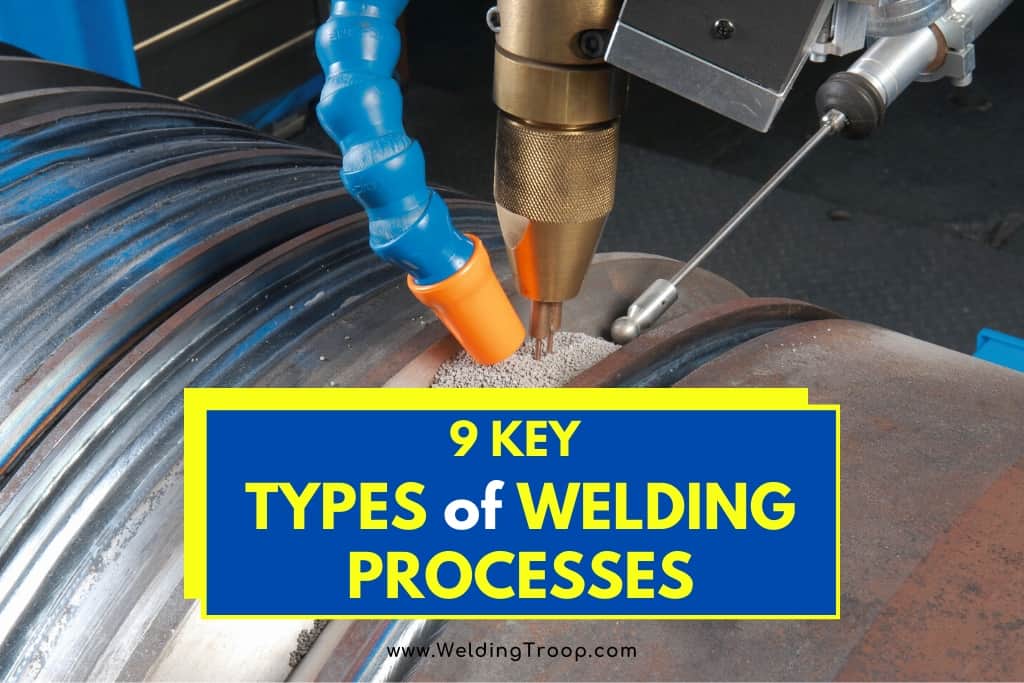Have you ever asked yourself what are the different types of welding processes? Well, welding is not just practical; it’s also an art form. Granted, the practical applications positively impact your daily life: bridges, your car, the girders for the building where you work, and the stores where you shop…to name a few.
You can find welding practices in many things from the soldering used for the most intricate jewelry design and your smartphone’s circuit board to the smooth joints of mammoth sculptures.
What types of welding processes are there? There are many specializations within the welding profession. Here are nine of them:
| 1 | MIG – Gas Metal Arc Welding (GMAW) | Also called Metal Inert Gas Welding (MIG). Provides the most consistent weld results. Some feel this is probably the easiest place to start for beginners. |
| 2 | TIG – Gas Tungsten Arc Welding (GTAW) | Also called Tungsten Inert Gas Welding (TIG). One of the neatest (cleanest) types of welding because it doesn’t create splatter. |
| 3 | Flux Cored Arc Welding (FCAW) | A great solution for tanks, boilers, and pipes that have thick plate metal. |
| 4 | Submerged Arc Welding (SAW) | Hot materials don’t splash, or splatter and the flux keeps high levels of radiation from escaping into the air. |
| 5 | Stick – Shielded Metal Arc Welding (SMAW) | This is also known as Stick Welding. Doesn’t require the gas shielding that TIG and MIG require and is very portable. It also works great outdoors for gates farm machinery, etc. |
| 6 | Thermit Welding | Allows for the fast joining of two dissimilar metals without requiring a power supply. |
| 7 | Oxyacetylene (Gas) Welding | Easy to learn and perform as well as being a low-cost solution. |
| 8 | Forge Welding | Best option for blacksmithing. |
| 9 | Resistance Welding | Is able to translate to very thin metals (0.1 millimeters) to this metals (20 millimeters). |
Welding is an important and in-demand skill set. Mike Rowe has said, “What matters most is the same stuff that’s always mattered. A willingness to work hard, to master a skill that’s in demand, and to go where the demand is.” To prove his point, here’s a closer look at the discipline of welding and the career opportunities within.
Table of Contents
Safety First – Tools of the Trade
Welding isn’t for casual dabbling – it’s one of the most dangerous tasks a professional in the trade industry can perform. Not sure you believe it? Consider this: intense heat, radioactive materials, blinding ultraviolet rays, and burning sparks – they’re all part of the job. It also isn’t for the fashion-conscious. Welding wear is made for function and protection.
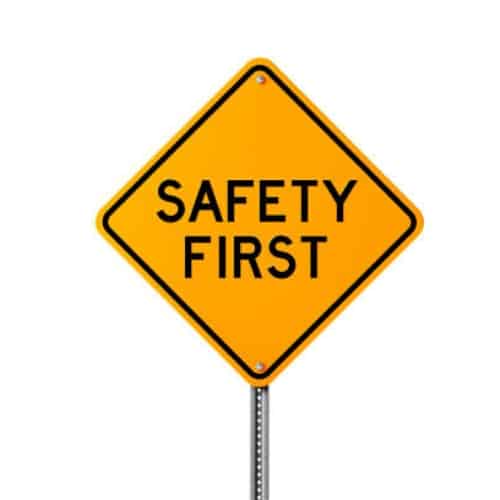
So, what personal protective equipment (PPE) is a required part of the trade? Check out the all-important protective wardrobe of the welder:
- Fire-resistant clothing and a jacket specifically designed for welding. You don’t want to look like an action-movie stunt professional who isn’t ready for that kind of flame!
- Welding gloves created for the welding process you are performing.
- High-top leather boots or shoes – steel-toed boots are best. Your footwear needs to be able to resist the rain of smoldering sparks that will land on them.
- Protective helmets and face shields. Just as you can get transitions lenses for your glasses, you can also get an auto-darkening helmet. These helmets will adjust their darkness according to the brightness of the sparks.
- Respirators are a good idea too. Particularly if you are working in an area with poor ventilation.
Four Major Categories within the Welding Profession
All of the welding disciplines generally fall within one of two categories: Fusion Welding processes and Plastic Welding processes. Each of those has several specializations within them.
Before we dive into the 4 major welding categories, check out the master chart of welding and allied processes.
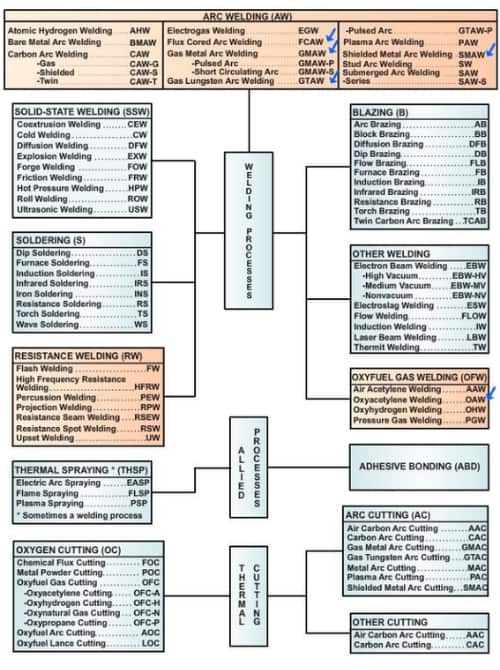
1. Fusion Welding
Heating two materials to the point of melting with the intent of bonding one to the other resulting in one joined piece. Because that’s just too easy, there are three different disciplines within the Fusion Welding category:
· Arc Welding
Arc welding is what most people think of when they think of welding. Kids in shop class often begin learning about stick welding. Whereas the oxyacetylene process uses gas, the arc welding process joins metals together by heat generated by an electric arc.
There are five specializations within the Arc Welding discipline:
a) Stick – Shielded Metal Arc Welding (SMAW) or Stick Welding
This is one of the most widely used welding processes. It requires the removal of the resulting slag from the weld after the welding process has been completed. Welders typically remove the slag by chipping it away and then filing it to make it smooth and neater.
I recently wrote an in-depth article about Stick Welding: Ultimate SMAW Guide, have a look at it.
This process works well for various construction projects, heavy equipment repair, and pipeline repair, among other jobs requiring something that can be portable.
Although it can take longer than other kinds of welding, Stick Welding can be effectively done in the rain or wind and doesn’t require gas shielding. One of its other advantages is that it’s easy to change rods when working on different types of metal.
This is also the type of welding that’s used when underwater welding is needed.
What is STICK Welding? (SMAW) >> Check out the video below
b) TIG – Gas Tungsten Arc Welding (GTAW) – also Called Tungsten Inert Gas Welding (TIG)
This welding process is generally used by advanced welders who have mastered their ability to create fine and delicate welds. They usually take more time and expertise to execute correctly than some of the other forms of welding.
As its name suggests, this welding process uses gas, typically Argon gas, to protect the melted weld puddle from airborne contaminants. TIG welding is known for producing precise and clean welds on any metal, whether that be:
- Alloys
- Aluminum
- Brass
- Bronze
- Chromoly
- Copper
- Gold
- Magnesium
- Nickel
- Steel or Stainless
One of the benefits of Gas Tungsten Arc Weld is that you don’t have to worry about slag, splatter, smoke, or fumes. Of course, if the metal you’re working on has any kind of contaminant: grease, lead, oil, paint, zinc, etc., you’re most likely going to experience either smoke or fumes – or both.
GTAW is a beneficial welding process for repairing your child’s Red Flyer Wagon, your bicycle frame, the snowblower, and even creating art pieces.
This process creates clean welds. So, if you’re concerned about the appearance of the weld, this is a good cosmetic process.
Since you control the heat output the same way you would the accelerator on your car or the needle speed on a sewing machine, you have control as to how much of a bead you create.
What is TIG Welding? >> Check out the video below
c) MIG – Gas Metal Arc Welding (GMAW) – Also Called Metal Inert Gas (MIG) Welding
This is the second-most popular welding technique after Stick Welding. Some consider it a somewhat archaic process, but it doesn’t require as much precision and isn’t as challenging as some of the other welding techniques.
One reason welders find this process easier to master is because it doesn’t require the level of precision other welding processes do. It can be managed with one hand because the electrode is automatically fed through the torch.
This process is often used for:
- Car repair
- Construction
- Dry Dock Maritime work
- Plumbing
- Robotics
The welder needs to be aware of the dross and porosity of the weld. If these aren’t properly cared for, the strength and integrity of the weld will be compromised.
What is MIG Welding? (GMAW) >> Check out the video below
d) Flux Cored Arc Welding (FCAW)
When working with this welding process, you will be using a wire with a flux-based center instead of using a shielding gas. This also works well outdoors because the flux does not easily blow off the weld and is not negatively impacted by dirty or rusted metals.
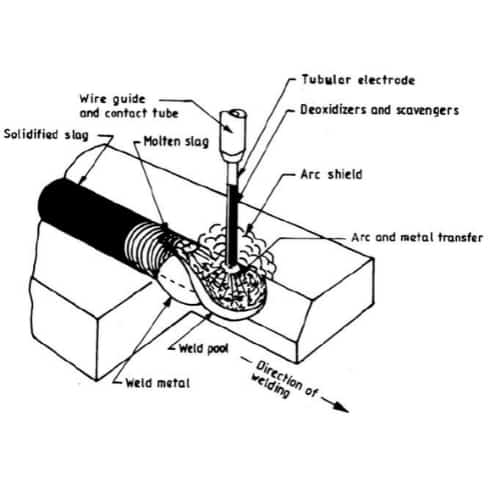
Although it produces a lot of smoke and splatter, it can get better penetration than one of the gas solutions.
This process is often used for hobby welding too.
What is Flux Cored Arc Welding? (FCAW) >> Check out the video below
e) Submerged Arc Welding (SAW)
In this process, the pieces of the welding procedure – the welding wire, the electrical arc, and the weld joint – are covered by a layer of flux. This creates a shield for the melted material and prevents spits and splatters. The barrier protects either the human or the robot performing the function.
Submerged Arc Welding works well for fast welds that are required by a high-productivity environment. That said, you are limited to using steel, stainless steel, and some types of nickel for SAW.
· Gas Welding also Called Oxyacetylene Welding
This process uses a mixture of fuel gases and oxygen within a torch to get to the high temperatures that are required for this process. At its hottest, this process gets to nearly 3,500 degrees Celsius (6,332 degrees Fahrenheit).
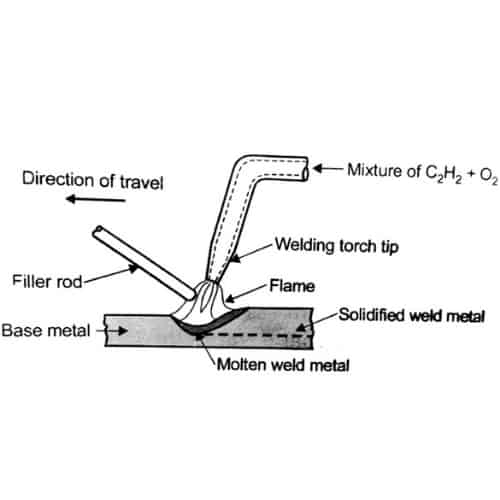
As a point of comparison, most gas grills only reach 500-550 degrees Fahrenheit, and the hottest wood pellet pizza oven on the retail market reaches 930 degrees Fahrenheit. This welding process reaches temperatures nearly seven times as hot as the hottest pizza oven available!
You’ll often find this process used with three different types of flames:
- Neutral Flame
- Carburizing Flame
- Oxidizing Flame
Some of the advantages of using Gas Welding processes include:
- It’s portable. The gas is stored under pressure in steel cylinders that can be mobile.
- It’s got some specially-designed safety devices, like flame traps.
- It’s versatile. In addition to being used for welding, this equipment can also be used to “flame-cut” larger materials.
- It’s fairly easy to learn and to apply those learnings.
- It’s relatively low cost.
· Thermit Welding
Thermit is a combination of aluminum powder and metal oxide. When it is ignited, it results in melted metal due to an exothermic non-violent reaction. That liquid metal is then poured where the welder wants it, and when it solidifies creates the weld joint.
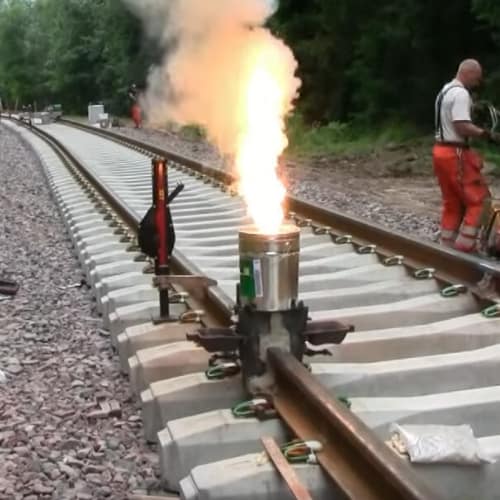
It tends to have a high cost associated with it, so it isn’t used as much as it was a century ago. It’s still used because it is a relatively simple and fast process that can be used to join both similar and dissimilar types of metals. Unlike some of the other processes, it also doesn’t require a significant power supply.
To get the required reaction, the Thermit mixture has to be heated to at least 1,300 degrees Celsius (about 2,372 degrees Fahrenheit).
2. Plastic Welding process
If you’ve ever accidentally left a plastic spatula or spoon on a hot pan, you know from experience that plastic does, indeed, melt and liquify.
Plastic welding uses that concept and forges a molecular bond between two compatible pieces of thermoplastic. This process usually requires the use of a thermoplastic welding rod to create the surface that can be bound to another.
That said, there are usually two different approaches to Plastic and Composite Welding:
- External Heating
- Internal Heating
Thermoplastics are preferred for this process because they can be melted and solidified multiple times. This can be accomplished through the use of a Hot Plate, Implant Tools, Laser or Infrared Tools, Radio Frequencies, Spin Processes, or Ultrasonic and Vibration Techniques.
This process is often used in:
- Automotive manufacturing and repair
- Medical equipment manufacturing
- Certain textile manufacturing
This welding process is beneficial because it can be used on any joint shape and can work with nearly any type of thermoplastic polymer. Another benefit is that it has a fairly low price point and works well for mass production processes.
3. Forge Welding
The concept of using a forge to heat or melt metal has been used for millennia. In fact, it’s considered to be the oldest welding method in existence.
Once the metal is heated to a malleable state, the professional is able to pound it into submission – literally. The heated metal is hammered into its new desired form and then cooled to set the process.
Blacksmiths working on horseshoes in old Westerns easily come to mind when thinking of the forging process, but it’s not limited to those professionals. Some common places where Forge Welding is used today include in the aerospace industry, the gun industry, and the automotive industry.
Although it is a slow process that requires a high skill level, it is popular because it doesn’t require any filler.
4. Resistance Welding
This relatively efficient and pollution-free welding process is a thermo-electric process during which electric resistance is used to create heat resulting in a liquid state of the materials to be joined together.
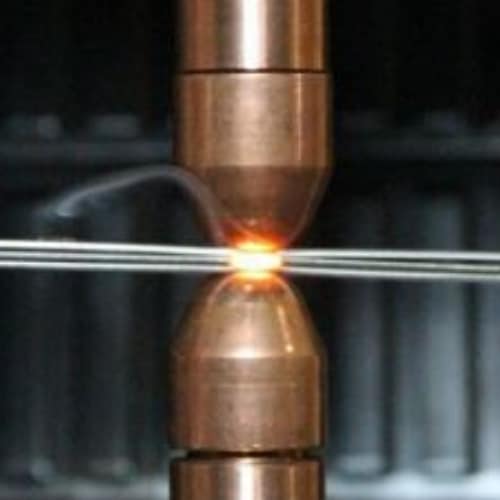
There are four well-known types of Resistance Welding:
| Flash Butt Welding | This is usually used in the steel industry to weld rods and tubes. This happens through the clamping of the two pieces in the electrode holders. |
| Projection Welding | This process is mostly used in the creation of nuts and bolts. To make this process work, a dimple is placed on the spot where the piece needs to be welded, and a large amount of current passes through it while pressure is applied through the electrode. This results in the dimple melting and flattening to create the weld. |
| Spot Welding | This is considered to be the least complicated type of resistance welding. This process is basically created by placing the two different pieces under the weight of an anvil and applying copper electrodes to the join spot to flow the current through them to melt them. The weld is then rapidly cooled. |
| Seam Welding | If you want an air-tight joint from a resistance welding process, this is the process you’d use. This is also known as Continuous Spot Welding. It’s considered continuous because the electrodes are in the form of a roller that ‘s used to flow the current to the pieces to be joined together. The current in the roller melts the pieces where they’re to be joined and creates one continuous weld joint. |
Welders are Incredibly Employable!
All of these different welding processes may seem a bit overwhelming – maybe even confusing, but did you know that there is a HUGE demand for welders in today’s job market?
This is a profession that is, without question, in high demand. As of the time of writing this article, one popular job board had over 3,800 active job listings for welders, another had over 2,400, and yet another had over 7,200.
Learn More About The Highest Paying Welding Jobs – Here, you can find an article from our website about: Do Welders Make Good Money? | Highest Paying Welding Jobs
That’s Great, But… How Does Someone Learn How to Become an Effective Welder?
Maybe you are looking for a new career, or you’re just starting out. Either way, there are a lot of Technical and Trade Schools fighting for your enrollment. If you’re concerned about the expense, here are just a few potential scholarship opportunities:
- The American Welding Society is a foundation that, according to its website, is dedicated to “advancing the science, technology, and application of welding and allied joining and cutting processes worldwide.”
- Nuts, Bolts, and Thingamajigs is a foundation of the Fabricators and Manufacturers Association, International.
- Mike Rowe’s Work Ethic Scholarship Program is a foundation dedicated to “reconnecting the average American with the value of a skilled workforce.”
There are also some large companies that have apprenticeships available so you could begin without foundation and learn on the job. If this is something you think you’d like to learn more about, you can check out the US Department of Labor’s site Apprenticeship.Gov.
Now you should have a better idea of how many different types of welding processes were out there. If you’re thinking about a career in the industry, check out the resources above and get started!
Related article: Where Do Welders Work?

